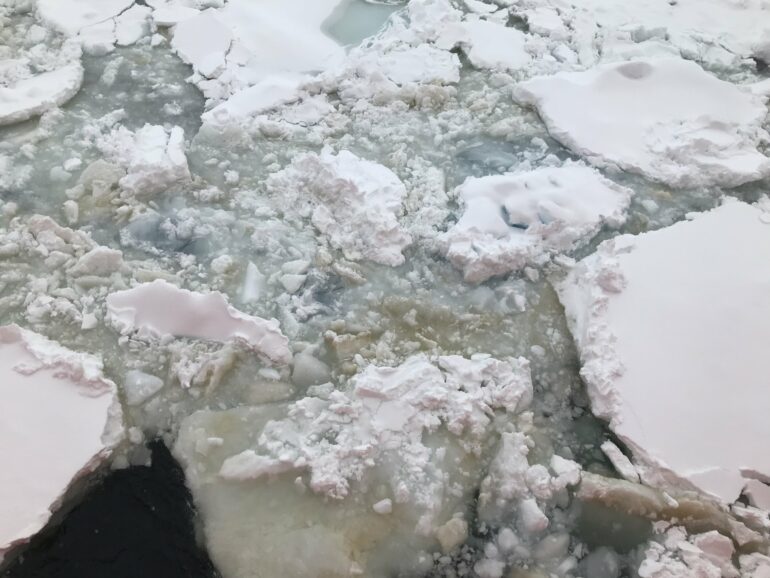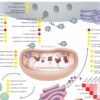In the frigid waters surrounding Antarctica, an unusual seasonal cycle occurs. During winter, from March to October, the sun barely rises. As seawater freezes it rejects salts, creating pockets of extra-salty brine where microbes live in winter. In summer, the sea ice melts under constant daylight, producing warmer, fresher water at the surface.
This remote ecosystem is home to much of the Southern Ocean’s photosynthetic life. A new University of Washington study provides the first measurements of how sea-ice algae and other single-celled life adjust to these seasonal rhythms, offering clues to what might happen as this environment shifts under climate change.
The study, published in the ISME Journal, contains some of the first measurements of how sea-ice microbes respond to changing conditions.
“We know very little about how sea-ice microbes respond to changes in salinity and temperature,” said lead author Hannah Dawson, a UW postdoctoral researcher who did the work while pursuing her doctorate in oceanography at the UW. “And until now we knew almost nothing about the molecules they produce and use in chemical reactions to stay alive, which are important for supporting higher organisms in the ecosystem as well as for climate impacts, like carbon storage and cloud formation.”
The polar oceans play an important role in global ocean currents and in supporting marine ecosystems. Microbes form the base of the food web, supporting larger life forms.
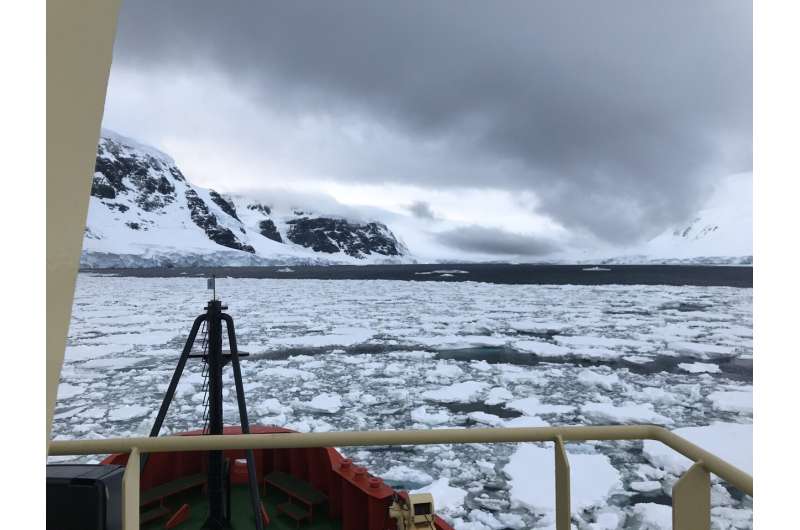
The sea ice off West Antarctica, seen here in October 2018, is a dynamic environment that experiences huge annual swings in light level, temperature and salinity, as well as the longer-term shifts of climate change. Algae and other microbes living in and around the sea ice are part of an understudied ecosystem. © Hannah Dawson/University of Washington
“Polar oceans make up a significant portion of the world’s oceans, and these are very productive waters,” said senior author Jodi Young, a UW assistant professor of oceanography. “These waters support big swarms of krill, the whales that come to feed on those krill, and either polar bears or penguins. And the start of that whole ecosystem are these single-celled microscopic algae. We just know so little about them.”
The tiny organisms are also important for the climate, since they quietly perform photosynthesis and soak up carbon from the atmosphere. Polar algae are especially good at producing sulfur-containing molecules that give beaches their distinctive smell and, when lofted into the air in sea spray, promote formation of clouds that can reduce penetration of solar rays.
Antarctic sea ice, though long stable, is at an all-time record low this year.
In other oceans, satellite instruments can capture dramatic seasonal phytoplankton blooms from space—but that isn’t possible for microbes hidden under sea ice. And Antarctic waters are particularly challenging to visit, leaving researchers with almost no measurements in winter.
In late 2018, Dawson and co-author Susan Rundell traveled to Palmer Station, a U.S. research station on the West Antarctic Peninsula. They used a small boat to sample seawater and sea ice at the same nearby sites every three days.
Back on shore, the two graduate students performed 10-day experiments in tanks to see which microbes grew as temperature and salinity were adjusted to mimic sea-ice formation and melt. They also shipped samples back to Seattle for more complex measurements of the samples’ genetics and metabolites, the small organic molecules produced by the cell.
Results revealed how single-celled algae deal with their fluctuating environments. As temperatures drop, the cells produce cryoprotectants, similar to antifreeze, to prevent their cellular fluid from crystallizing. Many of the most common cryoprotectant molecules were the same across different microbial lifeforms.
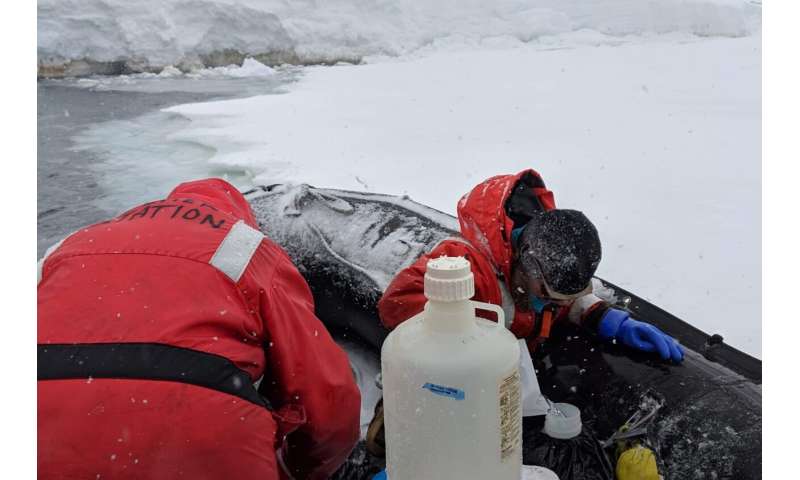
Co-authors Hannah Dawson (left) and Susan Rundell collect samples of seawater and sea ice off West Antarctica in November 2018. They put seawater in carboys wrapped in garbage bags (lower right) to avoid light contamination, and use an insulated cooler to store samples of sea ice. © Rebecca Trinh/Columbia University
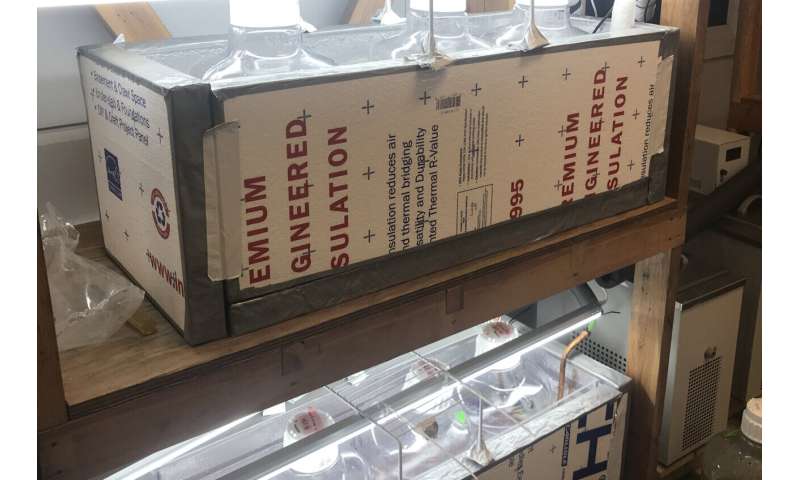
This experimental setup at Palmer Station in West Antarctica in November 2018 let researchers incubate samples at different temperatures and salinities to mimic seasonal changes in Antarctic waters. Results show that seawater microbes can survive these short-term changes by adjusting their production of organic molecules, rather than being replaced by different microbes specifically adapted to those new conditions. © Hannah Dawson/University of Washington
As salinity changes, to avoid either bursting in freshening waters or becoming desiccated like raisins in salty conditions, the cells change the concentration of salt-like organic molecules. Many such molecules serve a dual role as cryoprotectants, to balance conditions inside and outside the cell to maintain water balance.
The results show that under short-term temperature and salinity changes, community structure in each sample remained stable while adjusting the production of protective molecules. Different microbe species showed consistent responses to changing conditions. This should simplify modeling future responses to climate change, Young said.
Results also hint that the production of omega-3 fatty acids may decline in lower-salinity environments. This would be bad news for consumers of krill oil supplements, and for the marine ecosystem that relies on those algae-derived nutrients. Future research now underway by the UW group aims to confirm that result—especially with the prospect of increasing freshwater input from melting sea ice and glaciers.
“We’re interested in how these sea-ice algae contend with changes in temperature, salinity and light under normal conditions,” Dawson said. “But then we also have climate change, which is completely remodeling the landscape in terms of when sea ice is forming, how much sea ice forms, how long it stays before it melts, as well as the quantity of freshwater input from glaciers. So we’re both trying to capture what’s happening now, and also asking how that can inform what might happen in the future.”
More information:
Jodi Young et al, Microbial metabolomic responses to changes in temperature and salinity along the western Antarctic Peninsula, ISME Journal (2023).
Provided by
University of Washington
Citation:
Polar experiments reveal seasonal cycle in Antarctic sea ice algae (2023, September 14)
